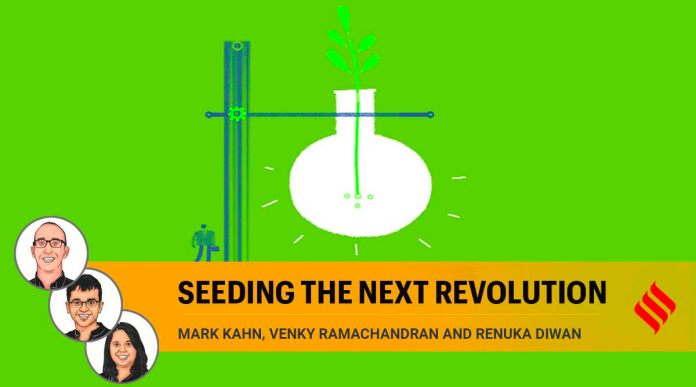Over the past few years, the transformative impact of technology on Indian agriculture has reached an inflection point and investor interest in agritech is at an all-time high. However, virtually all of the current startup activity and venture investing in agritech focuses on digital technologies, e-commerce, full-stack farmer platforms, rural fintech, and marketplaces. Innovations in agrifood life sciences remain deeply neglected by venture capital investors and even entrepreneurs. Every technological revolution, at some point in its evolution, faces strong limiting factors that prevent the technology from attaining its full potential. Technology historian Thomas Hughes called these limiting factors “reverse salients”. We believe agrifood life sciences is the reverse salient in Indian agritech and will ultimately hold back the transformation of Indian agriculture and food systems until it is addressed.
We think about agrifood life sciences as including four broad categories: Agricultural (Ag) biotechnology, novel farming systems, bioenergy and biomaterials, and innovative foods. Ag biotechnology includes on-farm inputs for crop and animal agriculture, including genetics, microbiome, breeding, and animal health. Novel farming systems include indoor farms, RAS aquaculture, insect protein, and algae production. Bioenergy and biomaterials include agri waste processing, biomaterials production, and feedstock technology. Finally, innovative foods refer to various forms of alternative proteins (plant-based, fermented, and cell-based), functional foods, and other novel ingredients. Globally, $6 billion was invested in agrifood life sciences startups in 2020, while their Indian peers, in aggregate, raised slightly over $10 million. India is becoming a global outlier, with the US, Israel, Europe, and China all building unicorn startups in agrifood life sciences.
The lacklustre state of entrepreneurial activity in agrifood life sciences is counterintuitive given how critical innovations in synthetic biology, chemistry, and biotechnology are for the future of Indian agriculture and food systems. Within a decade, Indian farmers will bear the full force of climate change, and digital technologies alone are insufficient to ensure a bright future in rural India. Innovations in agrifood life sciences can play a critical role in tackling both climate mitigation (reducing India’s GHG emissions) and climate adaptation/resilience (securing a future for India’s farmers). Agrifood life sciences will also create opportunities to completely reinvent agricultural value chains. India’s bounty of millets and pulses can be transformed into innovative plant-based proteins to meet global demand.
Unsustainable animal and aquaculture feed ingredients like fishmeal can be replaced with insect protein, creating a circular economy at scale. Finally, biological substitutes can be developed for traditional chemical fertilisers and pesticides, improving human and planetary health simultaneously. There are innumerable challenges ahead, but agrifood life sciences in India can meet them head-on with truly pathbreaking solutions.
The root cause of the moribund state of India’s agrifood life sciences ecosystem is perplexing. Many blame India’s de facto ban on new transgenic traits in seeds, but this can hardly account for the lack of startups in biological crop inputs, microbial biotechnologies, cellular alt protein, and animal/aquaculture health products. If regulatory challenges cannot account for the lack of vibrancy in India’s agritech life sciences ecosystem, then perhaps a lack of talent can. After all, the digital startup ecosystem in India was built by entrepreneurs and investors with global exposure, many of whom had been educated and/or worked abroad, including in Silicon Valley. In contrast, life science talent in India continues to migrate abroad at the earliest possible opportunity and rarely returns home. That said, with one-sixth of humanity supported by strong universities and research institutions, India surely has enough homegrown life science innovators to begin building a vibrant ecosystem.
So, if the lack of agrifood life sciences entrepreneurship cannot be laid at the feet of government policy, or a lack of domestic talent, perhaps the challenge is one of capital availability. If you look at Indian startup funding, it has historically ignored deep tech and hardware in favour of lower hanging fruit like e-commerce and fintech. Some of that is just because venture capital flows where it sees the largest and most easily executed opportunities. But part of it might be because most venture capitalists in India come from digital technology backgrounds, as opposed to having been trained in the life sciences. That’s not the case globally, where life science VCs are their own breed, mostly having PhDs and significant prior work experience in life sciences startups or the corporate pharmaceutical and biotech sectors.
The agrifood life sciences ecosystem in India needs to be rebooted, filled with talent, and catalysed with capital. Rebooting means taking stock of what is currently working, and what isn’t. The public sector has done more here than anyone gives them credit for, with DBT, BIRAC, C-CAMP, and NCL helping to support life sciences entrepreneurs in the absence of meaningful private investment. But agrifood life sciences startups still struggle terribly with the lack of wet laboratories and other critical infrastructure for synthetic biology. Universities and institutes (including CSIR and ICAR) rarely commercialise their intellectual property, oppose exclusive technology licensing on principle, and have failed to foster a spirit of entrepreneurship amongst their professors, graduate students, and researchers.
After two decades of anaemic progress, a new approach is required to accelerate agrifood life sciences in India. Whether developed by accelerators or research institutes, life sciences research and development infrastructure needs to be made available to entrepreneurs. Life sciences talent in the NRI community should be actively recruited to return to India and build the ecosystem here, as founders and senior leaders. Finally, venture investors of every stage need to step forward with funding to turn these dreams into our new reality. We are under no illusion that the path ahead for Indian agrifood life sciences will be easy. It will be an uphill journey for entrepreneurs, scientists, venture capitalists, and policymakers alike. But the future of Indian agriculture and food systems depends on the choices we make today.















